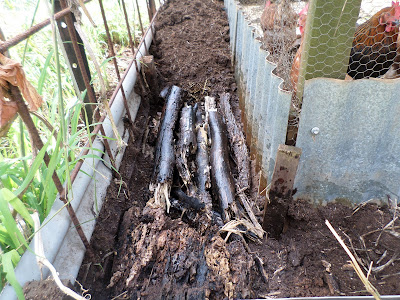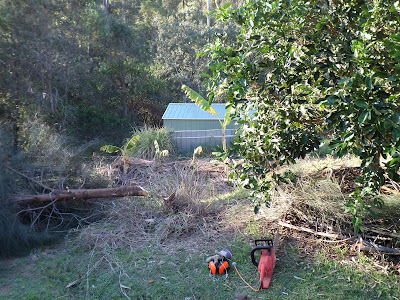For the past 21 days, I set some 20 chicken eggs, in our incubator. I forgot to turn the eggs, once, in the first week. You're supposed to turn them twice a day. Plus I had a temperature fluctuation, a few days in. It dropped by a few degrees, overnight. So I didn't even know if we were going to get any chicks at all.
Then on day 20, at precisely midday, our first egg hatched...
Egg #1
I wanted to check which eggs were viable, as we had a new rooster on the job. So I numbered all the eggs from one to twenty, as I collected them. Since they were only laying 3-4 eggs a day, it took several days to collect enough. Number one, was in the first group to be collected, so it was one of the oldest eggs. Can you guess which one hatched first? Yes, it was "1" and thus, we are naming them, number one.
Our eldest has taken a liking to them in particular, because they are both the first born in their family!
Drying
This is still number one, only a few more hours older. They're wet when first born, and once their down dries, they look like little fluff balls. Although the humidity in the incubator meant, their down didn't get completely dry yet.
The next egg to hatch however, was number eight.
Egg #8
Eight, came much later on day 20. Like, eight hours later at 8pm. Number eight, eight hours later, at eight PM! You will find many of the numbers have bizarre placements as we go along. But we worried initially, that the first chick would be a lone survivor. Because although several other eggs had pipped (meaning the chicks had broken the egg with their egg tooth) nothing much had happened for eight, excruciating hours!
Number eight, looks just like the first chick, only it has a dark coloured beak. As they are both yellow, they will both grow in white feathers. We're dealing with Isa Brown, crossed with a Leghorn rooster, who is also part Isa Brown. So the colours are all going to be very different!
The third, and last to be born on day 20, was number 16. They hatched just 45 minutes after the last, and at that point, we didn't known how many more would hatch the next day. Twenty-one days, is the final day. Anything after that, won't likely hatch or won't likely survive, if they do. As they tend to be too weak.
New arrivals, from eggs #15, #17 and #19
Sometime overnight however, three more hatched. The three up front (to the right) were the day 20 hatchlings. The single one to the left, and the two at the back, were the new arrivals. You can see, some more eggs had pipped, but we still didn't know what day 21 would bring. Sometimes nature doesn't always deliver, and the chicks simply die in their shells.
The next two eggs to hatch, virtually happened at the same time.
Egg #2
Number two hatched at 6.30am. We didn't see the other chicks hatch (we were alerted by their peeping instead) but it was amazing to see the chicks slowly emerge from their shells.
Nearly at the same time, number four, hatched...So number 2 and four, were 7th and 8th to hatch. We think of them, as the twins.
Egg #4
At this point, we were very happy with the outcome. Eight chicks, wasn't a bad turnaround, for something I wasn't sure would even succeed. But there were still more surprises to come.
Number fourteen, arrived at 6.45am, and a half hour later (at 7.15am) number ten made it! What is so funny about number ten is, their placement in the que.
Egg #10
Just as number one, came first - number ten, came tenth! Dab smack in the middle of 20 eggs, number ten, hatched tenth. I was glad in the fact, I decided to number them, as I collected their eggs from the nest. It made hatching all the more interesting!
Something bad happened after 10 though. My son got a hold of our camera. I normally kept it well out of reach, but I left it in the laundry to take pictures, as the chicks emerged. It just so happened, he dropped my camera after number 10 was born, and cracked something inside. It no longer works.
So the next photos, I took with the camera in my smart phone. Which happened to be after I relocated all the chicks, from out of the incubator and into the brooder.
Recovering in the brooder
We got quite a variety of colours in the end. Even some with racing stripes! That was egg number 20, and born eleventh. This racing stripe however, is indicative of a brown leghorn. We were never told which coloured leghorn, fathered our working rooster, but there was a chick born with feathers on it's legs too. So there's definitely more in the mix, than anyone knows.
In the end, we got 15 chicks out of 20 eggs. There was only one casualty. Number eighteen (born thirteen) made a lot of noise after they hatched. Plus they couldn't stand up initially. They kept flipping onto their back, with their feet in the air. I eventually assessed they had crooked neck, indicative of their inability to keep their head up, and a small lump on top of their head.
If you want to read about crooked neck, you can do so, here. It's most likely genetic, and it means part of the brain has been injured.
The brood
Luckily, I have successfully treated something similar before, and thus far, the chick has shown some improvement. They have more control over their neck, and can get about to eat and drink. You can see them in the picture above (bottom, centre) with a little red bump, poking through the top of their yellow down.
Egg #18, aptly named "Mumble" from the movie:
Happy Feet
I had to sprinkle some antiseptic power on top of that bump, to help disguise it. As the chicks kept pecking at it. That's how chicks learn to eat - by noticing things which stand out. They instinctively go over and peck at it.
We will have to watch and see how Mumble goes. They have been accepted by the group and hasn't been pecked at, since applying the powder. Which is a good sign. They all had their first day out on the grass already, and loved to sleep in the sunshine. Most of the time however, they stay in the heated brooder, as they can't regulate their body temperature yet.
Now we have to repatriate a chicken tractor for outside, since we totalled the last one. I can't believe it's taken us 6 years to fix it! I guess we've been busy.
In closing though, I thought to share something really fascinating about the eggs which didn't hatch. They were all odd numbers: 3, 5, 9, 11 and 13.





















































